Chapter 2.5 Book Review – Swami and Friends
Textbook Questions and Answers
Warming up!
Chit-chat:
1. Form groups of 3 to 4 and share the following with your groups.
- Your favourite book
- Type of book (short storieslbiography/thriller/adventure science fiction/historical) etc.
- Author/Writer
- Main character
- Background (Time and place)
- Problem/dilemma
- Any special message
2. You have recently read a short story/noveL/dramalscience fìctionlghost-story. Write in short 3 of its strong points that made you like the book and 2 or 3 drawbacks it has. Fill them up in the tree – diagram given.
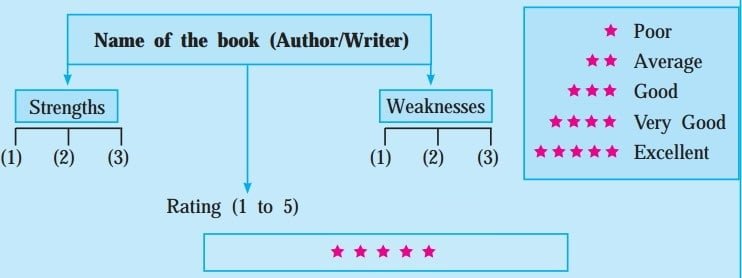
Question 1.
You have recently read a short story/novel/drama/science fìctionlghost-story. Write in short 3 of its strong points that made you like the book and 2 or 3 drawbacks it has. Fill them up in the tree – diagram given.
Answer:
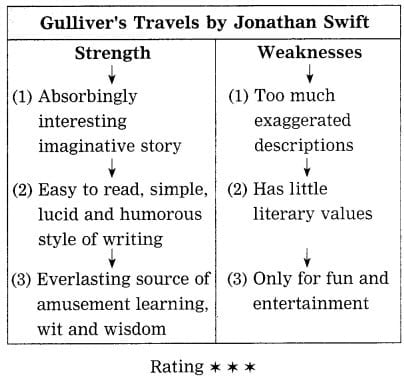
3. Determiners are words that modify a noun or noun phrase and occur before them in a sentence. Determiners provide a context to the noun they precede.
They may be:
- Articles – a, an, the
- Demonstratives – this, that, these, those, which etc.
- Possessives – my, your, our, their, liLs, her etc. my friend’s, her mother’s etc.
- Quantifiers – few, many, much, more, every, each, some etc.
- Numerals – one, four, hundred, first, fourth, hundredth
Question 1.
Determiners are words that modify a noun or noun phrase and occur before them in a sentence. Determiners provide a context to the noun they precede.
Answer:
They may be:
- Articles – a, an, the
- Demonstratives – this, that, these, those, which etc.
- Possessives – my, your, our, their, liLs, her etc. my friend’s, her mother’s etc.
- Quantifiers – few, many, much, more, every, each, some etc.
- Numerals – one, four, hundred, first, fourth, hundredth
4. Underline only Determiners in the following.
Question 1.
Underline only Determiners in the following.
- My brother bought a few magazines.
- What is your friend’s naine?
- Which writer was also the President of our country?
- These are some toys.
- These toys are new.
- That doctor is an expert dentist and he has many patients.
Answer:
- My brother bought a few magazines.
- What is your friend’s naine?
- Which writer was also the President of our country?
- These are some toys.
- These toys are new.
- That doctor is an expert dentist and he has many patients.
English Workshop:
1. Refer to the story ‘The Boy who Broke the Bank’ (Lesson 2.2.) by Ruskin Bond. Read it carefully and write a review of the same, referring the points given on Coursebook page 71 in mind.
(a) Name of Story and Writer/Author
(b) Type of story
(c) Background and setting (Time and Place)
(d) Main characters
(e) Problem faced
(f) Language used
(g) What you liked about the story
(h) What you did not like about it
(i) Your general opinion of the story
Question 1.
Refer to the story ‘The Boy who Broke the Bank’ (Lesson 2.2.) by Ruskin Bond. Read it carefully and write a review of the same, referring the points given on Coursebook page 71 in mind.
Answer:
Review of the story – The Boy who Broke the Bank
The story ‘The Boy who Broke the Bank’ is a very interesting and informative story written by Ruskin Bond, an eminent Indian author of British descent. It is a realistic social story full of wit and humour.
The main characters in the story are Nathu-the sweeper, Sitaram-the washerman’s son, Mrs Srivastava, Mrs Bhushan and Mr Bhushan, Kamal Kishore, the owner of the photographic shop, Deep Chand, the barber and an elderly gentleman and Ganpat, the begger.
The story is about the Pipalnagar Bank owned by Seth Govind Ram and the people of Pipalnagar. It begins at the steps of the Pipalnagar Bank when Nathu, the sweeper boy was sweeping the steps. He was irritated and decided to leave the job because he had not received his pay for the month. He told this to Sitaram, his friend and a washerman’s son. While delivering the clothes Sitaram told Nathu’s story to Mrs Srivastava who also needed a sweeper.
She, when met her friend Mrs Bhushan in bazaar, told her that the Bank is not able to pay the poor sweeper’s salary. Then from Mrs Bhushan to her husband, then to Deep Chand, to the barber and elderly gentleman, the news took different turns and twists and reached people to tell them that the Pipalnagar Bank has gone bankrupt. The rumour created havoc in Pipalnagar.
The news went from one man to another and from one place to another and spread over the whole bazaar and among all the customers of the Bank. Crash of the Pipalnagar Bank set everyone talking and speculating and rushing about in a frenzy. Many different rumours spread, moods of people aggravated and chaos was beyond control and it led to violence. The author has described and connected every incident in simple, easy language and depicted how a news spreads like wild fire without people going to the root of the fact.
He has used satirical style for emphasising the effects of rumours. The incidents of the elderly gentleman in the barber’s shop and the fake beggar’s (Ganpat’s) running at top speed, split our sides with laughter. liked the humour in the story and the tactful narration of the incidents to raise the awareness ‘ among the public about the rumours and their effects. According to my opinion it is a good read for a common man. It gives a good message to all.
2. Look inside your thinking hat.
Read the evidence/sentences given below and offer a possible explanation of what happened in this house? Make up some questions to gather more information.
Now collect all your evidence and write a story in your notebook. Give a suitable title.
Question 1.
Look inside your thinking hat.
Read the evidence/sentences given below and offer a possible explanation of what happened in this house? Make up some questions to gather more information.
Now collect all your evidences and write a story in your notebook. Give a suitable title.
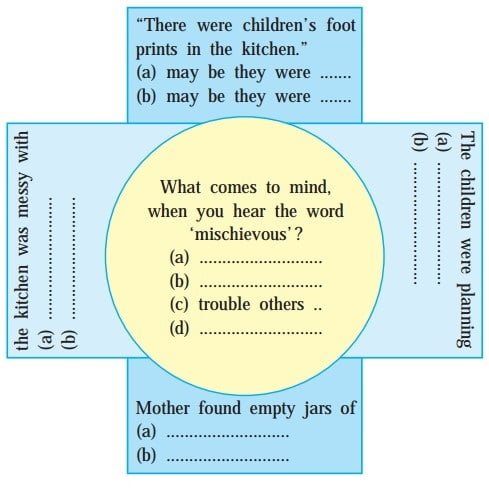
Answer:
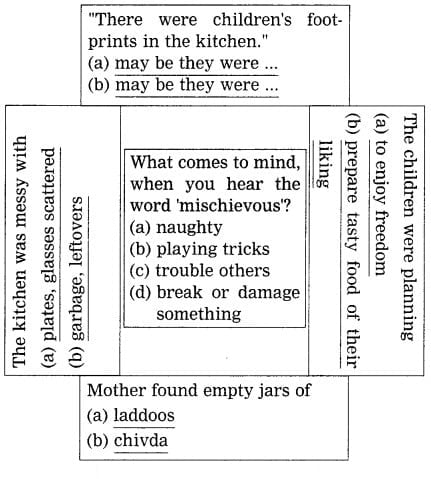
The Tiny Gang who robbed our kitchen!
My parents and I were leaving to Panvel to see one of our near relatives who was ill. Before leaving we warned my younger brother Chintu who was ten years old. We told him to stay with our uncle who was staying in the same building of ours on the ground floor and to have food with uncle in their house. We asked Chintu to keep the key to himself carefully and not to leave uncle’s room until we returned. He happily agreed.
We returned from Panvel late in the evening. Mother took the key from Chintu, went up and opened the lock. Mother put on the light and hurriedly went to the kitchen. She shouted loudly. I ran to her. Both of us were awfully shocked to see the kitchen in a messy state. Plates, glasses, pans, bowls and other utensils were scattered everywhere. The whole kitchen was untidy and dirty. Some gram flour and peels of boiled potatoes were scattered all over. We were panic-stricken. We thought that some thief must have entered our house to try his luck.
We called Chintu but he said he was at uncle’s house all the time. First we began to clear the mess. Mother lifted some tins and jars lying there and to her surprise the laddoos and chivda kept in them had vanished, gone! Who could it be and what the thieves must have taken away. But all other cupboards were intact.
When I examined the kitchen I found some children’s footprints in the scattered flour. In a flash I got it and deduced that it was the handiwork of the children, including Chintu. I instantly remembered that when we were leaving for Panvel, Chintu and some friends of his age were sitting in a space near the staircase, whispering something as if in secret. They were planning the day’s work.
I called all those mischievous, naughty children including Chintu before father. When father gave them harsh scolding and beating, they blurted out everything. The truth was revealed. In the noon when elderly persons were taking their naps, these boys entered our house, had a lot of fun, emptied the jars of laddoos and chivda and more than that they tried their hand on preparing Potato vadas on their own and hence they used gram flour and potatoes, but did not care to clean the mess. I should have been there to taste their Potato vadas!
3. Identify the new words and phrases which seem to be important, in the review. Try to guess their meaning from the context. You can use a dictionary to confirm it. Fifi up the table.
Question 1.
Identify the new words and phrases which seem to be important, in the review. Try to guess their meaning from the context. You can use a dictionary to confirm it. Fifi up the table.
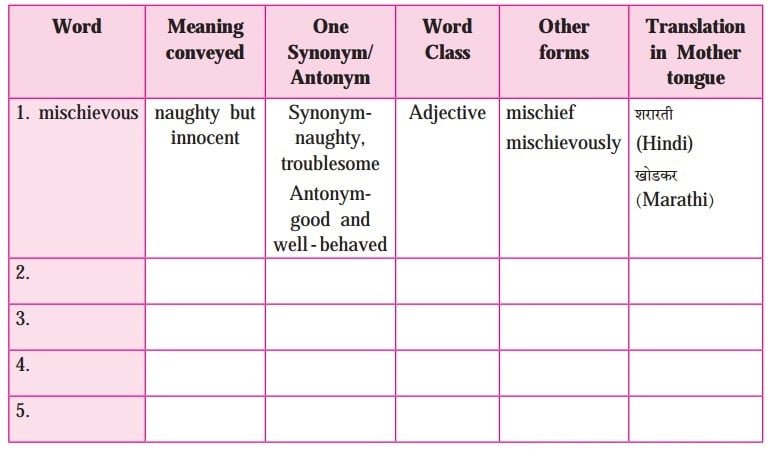
Answer:
(Note: Students should do this project on their own and present it in the class.)
4. (A) Find from the lesson the Noun forms of:
Question 1.
Find from the lesson the Noun forms of
(a) happen …………
(b) true ………….
(c) simple ……….
(d) conclude …………..
Answer:
(a) happen – happening
(b) true – truth
(c) simple – simplicity
(d) conclude – conclusion
(B) Find Verb forms of:
Question 1.
Find Verb forms of :
(a) hatred ……………..
(b) thought …………….
(c) meaning …………….
(d) improvement …………….
(e) description …………….
(f) attribution …………….
Answer:
(a) hatred – hate
(b) thought – think
(c) meaning – mean
(d) improvement – improve
(e) description – describe
(f) attribution – attribute
(C) Find Adjective forms of:
Question 1.
Find Adjective forms of:
(a) talk …………….
(b) interest …………….
(c) purity …………….
(d) technique …………….
(e) literature …………….
Answer:
(a) talk – talkative
(b) interest – interesting
(c) purity – pure
(d) technique – technical
(e) literature – literary
Tips For Reading For A Review (Guidelines)
Skimming – (While you read for a review you should know –
(a) What is the title/text/content?
(b) What exactly is to be read? (Selectivity)
(c) What support/related resources/references/help is to be generated or found?
(d) What will you search to get complete details/associated ideas?
(e) Use technology if required (web. e-books. gazettes) to correlate the content that is read.
scanning – We might use scanning to –
(a) Look up for meanings of related words/phrases/novel ideas.
(b) Find exact associations or inter – relationship of words.
(c) Check perfection in the start and finish time, while reading.
(d) identify the exact sequence of ideas and occurence of events.
(e) Use technology if required (web, e-books, gazettes) to correlate the content that is read.
Project – (A Book Review)
Write a complete review on any book that you have recently read. Use the points for your Book Review.
Question 1.
Write a complete review on any book that you have recently read. Use the points for your Book Review.
(a) Introduction
(b) Selectivity of contents
(c) Subject/Title Apporpriacy
(d) Sequence of Contents
(e) Language Appropriacy/Type
(f) Good Points/Novelty in the book.
(g) Advantages/Scope of the book. (if any)
(h) Demerits/Shortcomings (if any)
(i) Message/OpinionNiews (Personal)
(j) Conclusion (in short)
Answer:
Book: ‘Gulliver’s Travels’
Recently I read the book ‘Gulliver’s Travels’ by Jonathan Swift. It describes the strange and unique adventures, escapades and experiences of captain Lemuel Gulliver. I found it very interesting book. Out of four parts of the book first two – his voyage to Lilliput and the voyage to Brobdingnag are very amusing, funny and imaginative. But the other two parts are not that pleasant. In Lilliput, people were six inch tall and they treated Gulliver as a ‘man-mountain’.
In Brobdingnag people were sixty-feet high and Gulliver was just a pigmy before them. Many fearful as well as funny incidents hold us spell-bound. Though it has no big literary values or it does not preach you any moral values, it is a must read book for amusement. The book written in a simple, lucid and humorous style, is easy to read for entertainment. It is everlasting source of amusement and instruction, laughter and learning, wit and wisdom. It has become one of the finest of fairy tales.
Read the following passage and do the activities:
Simple Factual Activity:
Question 1.
State whether you Agree or Disagree with the following statements:
Answer:
- Swami is a close-mouthed little kid.
- Swami hated Mathematics worse.
- No event or parts of the story are mentioned in this book review.
- Mischievousness was the most striking quality of 10-year-old Swami.
Answer:
- Disagree
- Agree
- Agree
- Agree
Question 2.
State whether the following statements are True or False:
- The book is filled with heavy grammar and difficult technical words.
- The book circles round the mischief of the kids in a view of the kid.
- R. K. Narayan’s ‘Swami and Friends’ is a good read for the kids and teens alike.
- Mischievous kids are not as sensitive as other people.
Answer:
- The book is filled with heavy grammar and difficult technical words. – False
- The book circles round the mischief of the kids in a view of the kid. – True
- R. K. Narayan’s ‘Swami and Friends’ is a good read for the kids and teens alike. – True
- Mischievous kids are not as sensitive as other people. – False
Question 3.
Say whether the following statements are True or False:
- The author of ‘Swami and Friends’ is Ruskin Bond.
- This book is a good read only for kids.
- The author has written this book I to capture the spirit of the mind and life of a teenage kid.
- The Mahabharata’ is a great Indian Epic.
Answer:
- The author of ‘Swami and Friends’ is Ruskin Bond. – False
- This book is a good read only for kids. – False
- The author has written this book I to capture the spirit of the mind and life of a teenage kid. – True
- The Mahabharata’ is a great Indian Epic. – True
Complex Factual Activities:
Question 1.
Describe Swami’s characteristics in 3-4 sentences.
Answer:
Swami is a mischievous and talkative little kid of about 10 years old. He cannot stay at one place. He hates going to school, hates Mathematics even worse. School is a frightening and unpleasant experience for him. He always gets into trouble and a good beating from his father. All he wants to do is play under the sun, kick something, climb a tree break or damage something and harass (trouble) somebody. This is a typical life of the kid.
Question 2.
Complete the following sentences that tell you about author Narayan’s magic:
(Answers are directly given and underlined.)
Answer:
(a) Narayan gets deeply into the working of Swami’s ten-year-old mind.
(b) Explains in pleasing manner how Swami thinks.
(c) He too explains what is his perspective of the world is.
(d) The reader feels like Swami and gets attached with the character.
Question 3.
Complete the web
Answer:
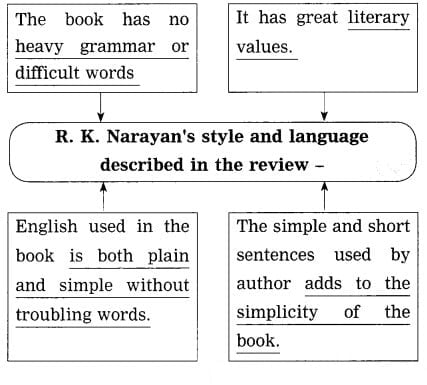
Question 4.
Why some parents may be worried about the description of a mischievous ten-year-old boy in the book? What does the reviewer say about it?
Answer:
Some parents may be worried about the description of a mischievous ten-year-old boy because they think, that might influence their already mischievous children. But the reviewer reassures them that the book describes the mischief of the kids in a view of the kid which is harmlessand pure.
Also amidst all the mischief and naughtiness, we actually find that Swami is a loving and tender kid who is really very sensitive. And it is a known fact that mischievous kids are most sensitive and loving people of all. So this is the message that the description conveys to all of us.
Question 5.
Complete the following web:
(Answer is directly given.)
Answer:
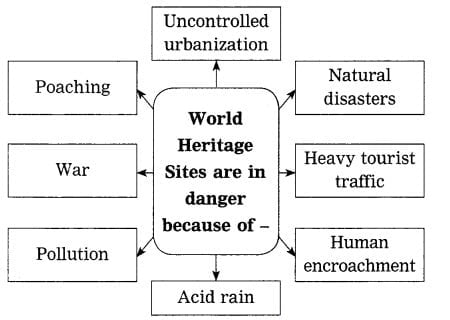
Question 6.
What information do you get from the passage about R. K. Narayan’s literary works from this passage?
Answer:
R. K. Narayan has produced many of the outstanding literary works India has ever produced. Apart from ‘Swami and Friends’ other great works by Narayan include ‘Malgudi Days’, ‘The Guide’, ‘The Painter Signs’ and many more literary works such as the shortened Modern Prose Versions of the Indian Epics ‘ The Ramayana’ and ‘The Mahabharata’.
Activities based on Vocabulary:
Question 1.
Underline the odd man:
(Answers are directly given and underlined.)
Answer:
- mentioning, happenings, everything, facing
- mischievous, truth, talkative, typical
- give, mention, stay, life
- constantly, absolutely, lovely, deeply
Question 2.
Find the following from the passage:
- Adjective forms of: mischief
- Noun forms of: naughty
- Verb forms of: imagination, loving
Answer:
-
mischief – mischievous
- naughty – naughtiness
- imagination – imagine, loving – love
Question 3.
Write from the passage the words related to ‘study’:
Answer:
book, literary values, literature, grammar, read, text, subject, technical words, English, genius, sentences.
Question 4.
Find the following from the passage:
- Noun forms of: rule
- Verb forms of: inclusion
- Adjective forms of: Britain
Answer:
- rule – rule/ruling
- inclusion – include
- Britain – British
Question 5.
Find the adjectives for the following from the passage:
- authors
- works
- rule
- Prose
- Epic
Answer:
- the greatest authors
- literary works
- British ruling
- modern prose
- Indian Epic
Activities based on Contextual Grammar:
Frame Wh-questions to get the underlined parts as answers:
Question 1.
Narayan gets deeply into the working of Swami’s mind.
Answer:
How does Narayan get into working of Swami’s mind?
Question 2.
That’s the magic of Narayan.
Answer:
Whose magic is that?
Find the error and rewrite the corrected sentences:
Question 1.
Swami think that’s his way of living life.
Answer:
Swami thinks that’s his way of living life.
Question 2.
Swami is an mischievous little kid.
Answer:
Swami is a mischievous little kid.
Question 3.
Technology isn’t big in kids life.
Answer:
Technology isn’t big in a kid’s life.
Question 4.
All they wants is to play havoc!
Answer:
All they want is to play havoc!
Add question tags:
Question 1.
This does not mean that the book is filled with heavy Grammar.
Answer:
This does not mean that the book is filled with heavy grammar, does this?
Question 2.
R. K. Narayan does a great job conveying that to all of us.
Answer:
R. K. Narayan does a great job conveying that to all of us, doesn’t he?
Do as directed:
Question 1.
The use of simple and short sentences adds to the simplicity of the book
(Rewrite the sentence using ‘not only … but also’)
Answer:
The use of not only simple but also short sentences adds to the simplicity of the book.
Question 2.
It is also known fact
(Complete the sentence by adding one more clause.)
Answer:
It is also known fact that small children yield to temptations.
Complete the following sentences adding one more clause:
Question a.
It can be said
Answer:
It can be said that you will find that atmosphere very pleasant.
Question b.
Take a look at the exhibition
Answer:
Take a look at the exhibition if you are interested in watching good photographs.
Do as directed:
Question 1.
The author is one of the greatest authors of all the time.
(Change the sentence into positive degree.)
Answer:
Very few (Not many) authors of all the time are so (as) great as him. (the author).
Question 2.
R. K. Narayan is responsible for many of the outstanding literary works.
(Frame a Wh-question to get the underlined as answer.)
Answer:
What is R. K. Narayan responsible for?
Personal Response:
Question 1.
Do you think, that even today most of our kids like to live the life Swami was living?
Answer:
Yes, I definitely think so. It is the natural instinct of most of the kids to play, to make fun, to play mischiefs and enjoy the life like Swami. They try to avoid going to school under some pretext and dislike to learn some particular subjects. They are often get beaten for their naughtiness, mistakes and their mischievous deeds. They do anything that comes to their mind, unintentionally.
Question 2.
What difference do you find between the children of Swami’s days and today’s children?
Answer:
I don’t think there is any peculiar difference between the children of Swami’s days and today’s children. Children all over the world and of all the times are the same. The only difference between them, according to me, is that many of today’s children keep themselves busy in mobiles, other gadgets and mobile games instead of playing in open space.
Question 3.
Which magazine for children do you like the most?Why?
Answer:
I like the magazine ‘Tin-Tin’ the most. I ike it because it provides all kinds of literature the children like. It gives fairy tales, mythological stories, historical stories, jokes and vivid information related to every field of children’s life. It also gives cartoons for the kids in view of the kids which are harmless and pure. It is a priceless gift for me, every month.
Activities based on Language Studies:
(A) Do as directed:
Question 1.
Complete the words by using correct letters:
- p r _ s e
- p l a _ e
- c l _ m b
- m _ g i c
Answer:
- p r o s e
- p l a c e
- c l i m b
- m a g i c
Question 2.
Put the following words in alphabetical order:
1. outstanding, author, prose, modern
2. conclusion, capture, can, children
Answer:
1. author, modern, outstanding, prose
2. can, capture, children, conclusion
Question 3.
Punctuate the following sentences:
1. he said it will be a difficult task,
2. “how s that?” said nathu. “Havent you heard.
Answer:
1. He said, “It will be a difficult task.”
2. “How’s that?” said Nathu. “Haven’t you heard?”
Question 4.
Make four words each (minimum 3 letters each) using the letters in the word ‘scattering’:
Answer:
catering, sing, ring, caring
Question 5.
Write related words as shown in the example:
(Answers are directly given and underlines.)
Answer:
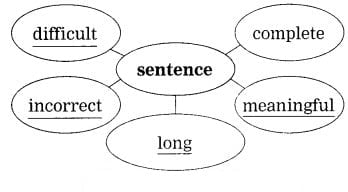
Question 6.
Complete the word-chain of verbs. Add four words, each beginning with the last letter of the previous word:
Lead → ___________ → ___________ → ___________ → ___________.
Answer:
Lead → deal → leave → eat → tell.
(B) Do as directed:
1. Attempt anyone:
a. Make your own meaningful sentence using the phrase ‘take a glance’.
Answer:
The officer took a glance through the report submitted by his assistant.
OR
b. Add a clause to expand the sentence meaningfully:
Swami is a kid ………………………
Answer:
Swami is a kid who cannot stay at one place.
2. Attempt anyone:
a. Add a prefix or suffix to make new words.
1. complete
2. justice
Answer:
1. completion
2. injustice
OR
b. Make a meaningful sentence using any one of the following words:
1. complete
2. justice
Answer:
1. I have to complete my work by tomorrow.
2. The employees were protesting against the owner to get justice.